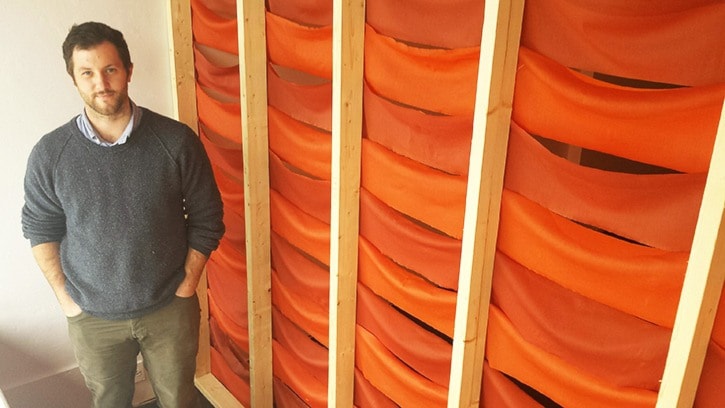As the ground violently shook beneath the feet of terrified bystanders on June 23rd 1946… it set events into motion that would take a young, inexperienced sailor on a path of transformation into one of Victoria’s emerging artists.
But, it’s been a long time coming for Brandon Poole.
With a few detours through journalism, photography, sailing, philosophy and carpentry –– Poole finally feels at peace with his craft.
The naturally shy, soft-spoken, fourth year Visual Arts student at the University of Victoria, can seem uncomfortable with the spotlight at times, but the walls start to break down when he talks about his latest work, currently being showcased by the not-for-profit, volunteer-run, fifty fifty arts collective.
His show – The Principle of Original Horizontality – runs until Nov. 6.
“It’s kind of a mad science project,” he said.
It’s similar, but a bit more sophisticated.
The project centres around a streamlined modern house built in 1946, the same year the largest earthquake to ever hit Vancouver Island occurred with an epicentre bullseyed on Campbell River. The exhibit features a flat-screen TV mounted to the wall in a semi-enclosed area at the back of the white-walled gallery.
The TV plays three video clips on a constant loop.
The first clip shows a house on Denison Road in Victoria’s south.
As Poole’s research progressed, the links between the house and Francis Denison — Victoria's first seismologist — takes an eerie turn.
“It seemed everywhere I turned, something would pop up. Like for instance … this house was being renovated when I encountered it and it was being seismically upgraded,” he said.
“A hundred and fifty metres from this house is the Gonzales Hall Observatory that was Denison designed and built, and where Victoria’s seismograph equipment was housed. Francis Denison also died a day after the 1946 earthquake. So there’s this odd sort of oscillation of events. … all this weird stuff that just kind of kept falling on to each other.”
The second clip is simply just a black screen, with a red laser level running across the middle of it.
Until the floor rumbles.
And then that precise red line jumps, like a heart beat on a monitor.
“The laser level line that is projecting into the space on top of the projection screen is playing out the earthquake that I got the seismogram information from the Geological Survey of Canada,” he explained.
There’s a contact microphone picking the vibrations in an eccentric rotating motor that’s attached to a subwhoofer, causing the space to shake.
The third clip is of a military green steel production machine, feeding and prepping blood red crepe paper through production. The vibrancy of the paper is carried through on to a large wooden frame, where it’s hung to create a laternesque look.
The exhibit showcases Poole’s creativity, intellect and philosophical sides, and challenges viewers to piece the puzzle together on their own.
“This is the first work I’ve done that I’ve made use of skills that I studied,” he said. “When I went to journalism school I was too shy to be a good journalist. I didn’t have the confidence to really get into other peoples stories, and I felt that this work is the first time I’ve chased leads. But that is the great thing about art; it doesn’t have to add up in any sort of coherent way. You can just gesture towards coincidences rather than have to state them out right. That being said, I have a lot of people come in and they want to know how it all connects, so I do end up talking about the connections.”
Poole’s vision caught the attention of judges who short-listed him for the Presentation’s House Gallery’s Lind Prize — a $5,000 award that supports emerging artists working with video, photography and film.
As this exhibit winds down, Poole looks to new inspirations for his next piece and merges more into the cinematic world of video.
“I’m interested in the relationship between images and objects … that really fine line that makes the jump from a photograph to a video. So many early work was just all set up the camera on the tripod and film and then let things happen in the space in the composition and so that work there that you saw of the Christmas cracker machine, is the most cinematic work I’ve done so far,” he said.
Poole will be part of panel discussion Nov. 5 from 1:30 p.m. to 3:30 p.m. at Open Space for a panel discussion with Victoria artists Trudi Lynn Smith, Cedric Bomford, Brandon Poole as well as artists from the current exhibition The Absence Of The Origin Of Its Likeness, Arnold Koroshegyi, and Laura Dutton. Each artist will introduce his/her own practice and will then engage in a discussion around contemporary photography. Lynda Gammon will moderate the panel and audience participation will be encouraged.
